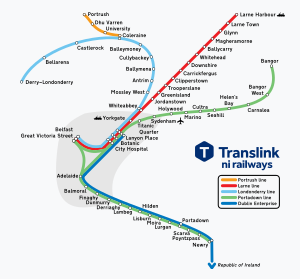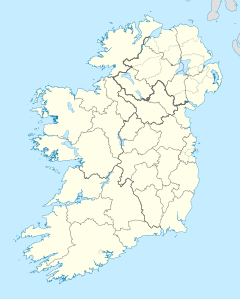Bangor Bus and Rail Centre
 Bangor Combined Railway and bus station was formally opened in 2001. | ||||||||||||||||||||||||||||||||||||||||||||||||||||||||||||||||||||||||||||||||||||||||||||||||||||||||||||||||||||||||||||||||||||||||||||||||||||||||||||||||||||||||||||||||||||||||||||||||||||||||||||||||||||||||||||
| General information | ||||||||||||||||||||||||||||||||||||||||||||||||||||||||||||||||||||||||||||||||||||||||||||||||||||||||||||||||||||||||||||||||||||||||||||||||||||||||||||||||||||||||||||||||||||||||||||||||||||||||||||||||||||||||||||
| Location | Bangor Northern Ireland | |||||||||||||||||||||||||||||||||||||||||||||||||||||||||||||||||||||||||||||||||||||||||||||||||||||||||||||||||||||||||||||||||||||||||||||||||||||||||||||||||||||||||||||||||||||||||||||||||||||||||||||||||||||||||||
| Coordinates | 54°39′31″N 5°40′21″W / 54.6585°N 5.6725°W | |||||||||||||||||||||||||||||||||||||||||||||||||||||||||||||||||||||||||||||||||||||||||||||||||||||||||||||||||||||||||||||||||||||||||||||||||||||||||||||||||||||||||||||||||||||||||||||||||||||||||||||||||||||||||||
| Owned by | NI Railways | |||||||||||||||||||||||||||||||||||||||||||||||||||||||||||||||||||||||||||||||||||||||||||||||||||||||||||||||||||||||||||||||||||||||||||||||||||||||||||||||||||||||||||||||||||||||||||||||||||||||||||||||||||||||||||
| Operated by | NI Railways | |||||||||||||||||||||||||||||||||||||||||||||||||||||||||||||||||||||||||||||||||||||||||||||||||||||||||||||||||||||||||||||||||||||||||||||||||||||||||||||||||||||||||||||||||||||||||||||||||||||||||||||||||||||||||||
| Line(s) | Bangor | |||||||||||||||||||||||||||||||||||||||||||||||||||||||||||||||||||||||||||||||||||||||||||||||||||||||||||||||||||||||||||||||||||||||||||||||||||||||||||||||||||||||||||||||||||||||||||||||||||||||||||||||||||||||||||
| Platforms | 3 | |||||||||||||||||||||||||||||||||||||||||||||||||||||||||||||||||||||||||||||||||||||||||||||||||||||||||||||||||||||||||||||||||||||||||||||||||||||||||||||||||||||||||||||||||||||||||||||||||||||||||||||||||||||||||||
| Tracks | 3 (At Platforms) 4 (In Total) | |||||||||||||||||||||||||||||||||||||||||||||||||||||||||||||||||||||||||||||||||||||||||||||||||||||||||||||||||||||||||||||||||||||||||||||||||||||||||||||||||||||||||||||||||||||||||||||||||||||||||||||||||||||||||||
| Construction | ||||||||||||||||||||||||||||||||||||||||||||||||||||||||||||||||||||||||||||||||||||||||||||||||||||||||||||||||||||||||||||||||||||||||||||||||||||||||||||||||||||||||||||||||||||||||||||||||||||||||||||||||||||||||||||
| Structure type | At-grade | |||||||||||||||||||||||||||||||||||||||||||||||||||||||||||||||||||||||||||||||||||||||||||||||||||||||||||||||||||||||||||||||||||||||||||||||||||||||||||||||||||||||||||||||||||||||||||||||||||||||||||||||||||||||||||
| Key dates | ||||||||||||||||||||||||||||||||||||||||||||||||||||||||||||||||||||||||||||||||||||||||||||||||||||||||||||||||||||||||||||||||||||||||||||||||||||||||||||||||||||||||||||||||||||||||||||||||||||||||||||||||||||||||||||
| 1865 | Original station opened | |||||||||||||||||||||||||||||||||||||||||||||||||||||||||||||||||||||||||||||||||||||||||||||||||||||||||||||||||||||||||||||||||||||||||||||||||||||||||||||||||||||||||||||||||||||||||||||||||||||||||||||||||||||||||||
| 2001 | Current station opened | |||||||||||||||||||||||||||||||||||||||||||||||||||||||||||||||||||||||||||||||||||||||||||||||||||||||||||||||||||||||||||||||||||||||||||||||||||||||||||||||||||||||||||||||||||||||||||||||||||||||||||||||||||||||||||
| Passengers | ||||||||||||||||||||||||||||||||||||||||||||||||||||||||||||||||||||||||||||||||||||||||||||||||||||||||||||||||||||||||||||||||||||||||||||||||||||||||||||||||||||||||||||||||||||||||||||||||||||||||||||||||||||||||||||
| 2022/23 | 1.301 million [1] | |||||||||||||||||||||||||||||||||||||||||||||||||||||||||||||||||||||||||||||||||||||||||||||||||||||||||||||||||||||||||||||||||||||||||||||||||||||||||||||||||||||||||||||||||||||||||||||||||||||||||||||||||||||||||||
| 2023/24 | ||||||||||||||||||||||||||||||||||||||||||||||||||||||||||||||||||||||||||||||||||||||||||||||||||||||||||||||||||||||||||||||||||||||||||||||||||||||||||||||||||||||||||||||||||||||||||||||||||||||||||||||||||||||||||||
| ||||||||||||||||||||||||||||||||||||||||||||||||||||||||||||||||||||||||||||||||||||||||||||||||||||||||||||||||||||||||||||||||||||||||||||||||||||||||||||||||||||||||||||||||||||||||||||||||||||||||||||||||||||||||||||
| ||||||||||||||||||||||||||||||||||||||||||||||||||||||||||||||||||||||||||||||||||||||||||||||||||||||||||||||||||||||||||||||||||||||||||||||||||||||||||||||||||||||||||||||||||||||||||||||||||||||||||||||||||||||||||||
Bangor Bus and Rail Centre is a combined rail and bus interchange which serves the city of Bangor in County Down, Northern Ireland.
The station in its current form was built in the year 2000 to celebrate the new millennium
History
[edit]The station was opened by the Belfast and County Down Railway on 1 May 1865 and closed to goods traffic on 24 April 1950.
Daylight saving time was introduced by the Summer Time Act 1916 and implemented on 1 October 1916 as GMT plus one hour and Dublin Mean Time plus one hour. However, Dublin Mean Time (used by the railways) had a disparity of twenty-five minutes with Greenwich Mean Time, which meant that the Bangor Railway Station Clock was to be put back only thirty-five minutes instead of one hour. An additional complication was that the clocks in Belfast and Bangor were twenty-three minutes and thirty-nine seconds behind Greenwich Mean Time (not twenty-five minutes as in Dublin), so the final adjustment was thirty-six minutes and twenty-one seconds. The change to the time displayed on the Bangor Station Clock was not welcomed by commuters.[3]
The station buildings were originally erected in 1864–1865 to designs by the architect Charles Lanyon.[4] Following World War 2, however, refurbishments made by the Ulster Transport Authority to this Italianate structure damaged the original Lanyon-designed building, stripping it of much of its original brickwork. The company then rebuilt the building, before it was reconstructed again to a new design in 2000.
In the year 2000, then-mayor of Bangor Alan Chambers sealed a time capsule near the entrance of the station which is to be opened in 2100.[citation needed]
Services
[edit]Mondays to Saturdays there is a half-hourly service toward Belfast Grand Central. Extra services operate at peak times and reduce to hourly operation in the evenings. Certain peak-time services from this station operate as expresses between Bangor West and Holywood or Belfast Lanyon Place.
On Sundays, there is an hourly service to Belfast City Centre and onward.
References
[edit]- ^ "FOI1317 NIR Footfall 2223.xlsx". www.whatdotheyknow.com. 17 April 2023. Retrieved 27 May 2024.
- ^ "FOI Footfall 2023 2024 figures PDF.pdf". www.whatdotheyknow.com. 7 May 2024. Retrieved 30 May 2024.
- ^ Elder, Ellen Hanna. "An Idea Whose Time Had Come." Your Place & Mine. BBC Northern Ireland. Retrieved 13 December 2020.
- ^ "Lanyon, Lynn & Lanyon - Works". Dictionary of Irish Architects. Irish Architectural Archive. Retrieved 20 September 2024.




